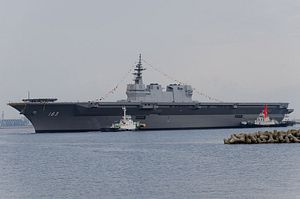With Izumo in hand, what’s next for the Japanese Maritime Self Defense Force?
As several contributors have noted, JDS Izumo has entered service with the Japanese Maritime Self-Defense Force. Izumo is the largest carrier (or “helicopter-carrying destroyer”) constructed by Japan since World War II. The 27,000 ton, 31 knot flat-decked warship gives the JMSDF critical advantages in anti-submarine and amphibious capabilities, and immediately becomes one of the most effective units in the Asia-Pacific.
Izumo and her sister represent an evolutionary step beyond the Hyuga-class light carriers, which displace about 19,000 tons. With the experience gained from construction and operation of the Izumos, Japan could easily take the next step to an even larger flat-decked amphib, or potentially to a full fleet carrier.
However, the JMSDF faces two significant obstacles in pushing to the next step in carrier evolution.
First, the current geopolitical environment may not require the JMSDF to operate anything larger than Izumo and her sister. Japan does not, at the moment, require power-projection capabilities, and any demand for such capabilities is ably filled by the carriers of Japan’s primary ally, the United States. If the strategic environment changes in the future to a point where Japan requires either a) a strike capability, or b) active fleet air defense, then the JMSDF could consider building larger carriers. Equipping the Izumos with F-35B VSTOL Joint Strike Fighters could help bridge a short term gap in capability if Japan determines that it does require full carrier capability, although the limitations of both the Izumos and the F-35B make this option less preferable than dedicated fleet carriers. Izumo could also carry attack helicopters in her current configuration, which fits with recent global practice of using helicopters in a strike role.
The more difficult problem lies with the historical legacy of Japanese naval power. Naval aviation represented the “killer app,” enabling Japan’s conquest of East and Southeast Asia in the 1930s and 1940s. This legacy, poisonous in the region and in Japan, is why the JMSDF remains reluctant to call its aircraft carriers by their name, even as India and China flaunt their naval aviation progress. If Japan constructed a carrier with serious offensive capabilities (or even took fullest advantage of what the Izumos can offer), it would supply anti-Japanese activists in China, Korea, and elsewhere with fodder about Japanese aggression.
For now, the image of a reborn Kido Butai frightens many Japanese as much as it does Japan’s neighbors. But given that India, China, and possibly Russia appear committed to increasing the size and sophistication of their carrier fleets, in the future it may become easier for Japan to envision a force of fleet carriers. The JMSDF should have contingency plans on hand for both maximizing the potential of the Izumos as well as looking to the next generation of carriers.

































